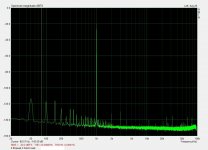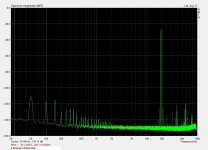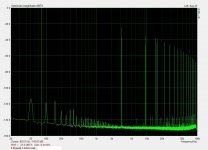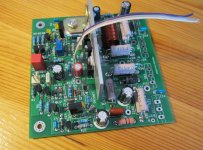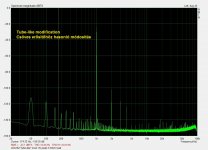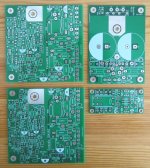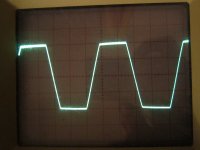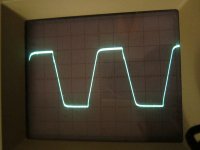Hi,
I have a low noise, low distortion distortion transistor audio power amplifier design. Built 2 mono and 3 stereo prototypes so far that work fine. This is a DiY design, but I believe it was more carefully tested under non-ideal conditions than the majority of DiY designs we encounter on the internet. The 1 kHz THD was measured 0.0006%...0.0013% on the prototypes depending on power level and load (loads down to 3.5 ohms, output power from 0.2 Watts up to 200 Watts /3.5 ohms). Below 0.2 watts, distortion harmonics are masked in the noise floor of my equipment even with averaging. Other kind of more challenging distortions like 19+20 kHz IMD and TIM(DIM) -- see images -- are low at all power levels and at all permitted loads. Capable of 200 Watts/ 4 ohms or 110 Watts /4 ohms output power depending on component set.
A nulltest (google "audio nulltest" if you don't know what it is) showed that the amplifier has no audible distortion at normal listening volumes, so it can be considered as totally transparent sonically. (Well, I understand some people like audible distortions if they color the sound pleasantly or interestingly. So this amp is for people who rather like reality.)
My open-ended offer is that I send you the kit you choose (one of the 4 different kits that are available) at a non-profit price. This means you'll get the specified PCB's and components at the price I bought them, and I won't charge my wage of labor either. I do this to make this design and the kits more popular among DiYers. I only ask in return: please give me feedback how I can improve the completeness and quality of the online information, especially the assembly instructions.
All kits contain the low distortion power amplifier board(s), power supply board(s) and protection board(s) and the components to populate the boards as covered in the online documentation. (User selectable components like chassis, main heatsink, main filter capacitors, power transformer(s) etc. are not part of the kits.)
http://euraudio.dx.am/en/amp/LDA/lda_np_kits_en.htm
The home page of the LDA amplifier is this, where you'll find links to all information that is available right now (kit descriptions, specifications, assembly instructions, some measurements and listening tests):
LDA home
The circuitry is more complicated than the majority of DiY projects, it is not for beginners. If you don't have proven experience in audio amplifier construction, please don't buy it! (If you make a mistake and some components are blown, I can't help in troubleshooting, I can only resend the whole component set for the faulty circuit at the non-profit price until this sale is offered.)
The LDA MIN_np kit is the simplest and cheapest (2x100W stereo) kit of the 4, it has only a minimalist protection circuitry. The LDA 53DM_np kit is the most expensive and most reliable (2x200W dual mono) kit; regarding protection, it survived 3 output short circuits during the testing without degradation of output signal quality due to the fast acting ultra low distortion solid state relay in it.
You must pay the shipping costs, which may be significant outside of Europe (shipping is from Hungary).
Right now I have in stock components for 4 mono amplifiers (or 2 dual mono or 2 stereo). If there will be interest in more non-profit kits than this, then I'll need about 2 weeks to buy the necessary components.
Most of the kits are available on the German and UK ebays and some of them on the Hungarian vatera.hu. The price there contains the fee I need to pay ebay or vatera for the transaction.
If you are in the UK, in Germany, in Hungary, or in an English speaking country where ebay is present, then you can ask me to list your chosen kit on ebay if it is not listed.
If you're in another, non-English speaking country, I think you should transfer the non-profit price of the kit + shipping cost to my PalPay account in advance, which you could rightfully consider unsafe. Still thinking about registering on Amazon...
If you have any question, please ask.
[The image shows only the amplifier board without the output transistors and the tempco transistor. Those transistors are also part of the kits as well as other PCB's with the components specified in the assembly instructions, which, in most cases, are all the electronic and mechanical components that populate the PCB's.]
http://euraudio.dx.am/en/amp/LDA/LDA_53DM_np_assy.htm
http://euraudio.dx.am/en/amp/LDA/LDA_43S_np_assy.htm
http://euraudio.dx.am/en/amp/LDA/LDA_53M_np_assy.htm
http://euraudio.dx.am/en/amp/LDA/LDA_MIN_np_assy.htm
Istvan
I have a low noise, low distortion distortion transistor audio power amplifier design. Built 2 mono and 3 stereo prototypes so far that work fine. This is a DiY design, but I believe it was more carefully tested under non-ideal conditions than the majority of DiY designs we encounter on the internet. The 1 kHz THD was measured 0.0006%...0.0013% on the prototypes depending on power level and load (loads down to 3.5 ohms, output power from 0.2 Watts up to 200 Watts /3.5 ohms). Below 0.2 watts, distortion harmonics are masked in the noise floor of my equipment even with averaging. Other kind of more challenging distortions like 19+20 kHz IMD and TIM(DIM) -- see images -- are low at all power levels and at all permitted loads. Capable of 200 Watts/ 4 ohms or 110 Watts /4 ohms output power depending on component set.
A nulltest (google "audio nulltest" if you don't know what it is) showed that the amplifier has no audible distortion at normal listening volumes, so it can be considered as totally transparent sonically. (Well, I understand some people like audible distortions if they color the sound pleasantly or interestingly. So this amp is for people who rather like reality.)
My open-ended offer is that I send you the kit you choose (one of the 4 different kits that are available) at a non-profit price. This means you'll get the specified PCB's and components at the price I bought them, and I won't charge my wage of labor either. I do this to make this design and the kits more popular among DiYers. I only ask in return: please give me feedback how I can improve the completeness and quality of the online information, especially the assembly instructions.
All kits contain the low distortion power amplifier board(s), power supply board(s) and protection board(s) and the components to populate the boards as covered in the online documentation. (User selectable components like chassis, main heatsink, main filter capacitors, power transformer(s) etc. are not part of the kits.)
http://euraudio.dx.am/en/amp/LDA/lda_np_kits_en.htm
The home page of the LDA amplifier is this, where you'll find links to all information that is available right now (kit descriptions, specifications, assembly instructions, some measurements and listening tests):
LDA home
The circuitry is more complicated than the majority of DiY projects, it is not for beginners. If you don't have proven experience in audio amplifier construction, please don't buy it! (If you make a mistake and some components are blown, I can't help in troubleshooting, I can only resend the whole component set for the faulty circuit at the non-profit price until this sale is offered.)
The LDA MIN_np kit is the simplest and cheapest (2x100W stereo) kit of the 4, it has only a minimalist protection circuitry. The LDA 53DM_np kit is the most expensive and most reliable (2x200W dual mono) kit; regarding protection, it survived 3 output short circuits during the testing without degradation of output signal quality due to the fast acting ultra low distortion solid state relay in it.
You must pay the shipping costs, which may be significant outside of Europe (shipping is from Hungary).
Right now I have in stock components for 4 mono amplifiers (or 2 dual mono or 2 stereo). If there will be interest in more non-profit kits than this, then I'll need about 2 weeks to buy the necessary components.
Most of the kits are available on the German and UK ebays and some of them on the Hungarian vatera.hu. The price there contains the fee I need to pay ebay or vatera for the transaction.
If you are in the UK, in Germany, in Hungary, or in an English speaking country where ebay is present, then you can ask me to list your chosen kit on ebay if it is not listed.
If you're in another, non-English speaking country, I think you should transfer the non-profit price of the kit + shipping cost to my PalPay account in advance, which you could rightfully consider unsafe. Still thinking about registering on Amazon...
If you have any question, please ask.
[The image shows only the amplifier board without the output transistors and the tempco transistor. Those transistors are also part of the kits as well as other PCB's with the components specified in the assembly instructions, which, in most cases, are all the electronic and mechanical components that populate the PCB's.]
http://euraudio.dx.am/en/amp/LDA/LDA_53DM_np_assy.htm
http://euraudio.dx.am/en/amp/LDA/LDA_43S_np_assy.htm
http://euraudio.dx.am/en/amp/LDA/LDA_53M_np_assy.htm
http://euraudio.dx.am/en/amp/LDA/LDA_MIN_np_assy.htm
Istvan
Attachments
Last edited:
You should require for purchase that buyers have proven experience in audio amplifier construction.
Otherwise, you'll have to deal with the usual beginner's problems and melt-downs.
Otherwise, you'll have to deal with the usual beginner's problems and melt-downs.
Last edited:
You should require for purchase that buyers have proven experience in audio amplifier construction.
Otherwise, you'll have to deal with the usual beginner's problems and melt-downs.
Really ? So someone who wants to buy them as a gift are SOL. That’s nice thing to do
It’s a great job and offer the OP is doing
To bad it’s not available for us in the USA
Anyway. Great work
Really ? So someone who wants to buy them as a gift are SOL. That’s nice thing to do
It’s a great job and offer the OP is doing
To bad it’s not available for us in the USA
Anyway. Great work
It's just that I'm not registered on Amazon and I don't know how Amazon works. Maybe I should resgister and could sell worldwide. Someone should persuade me to do so.
But I believe there are many nice DiY amplifiers located closer to the US.
Istvan
It's just that I'm not registered on Amazon and I don't know how Amazon works.
Maybe I should resgister and could sell worldwide. Someone should persuade me to do so.
I wouldn't get involved with Amazon, lots of overhead. Take things very slowly.
Be sure to use tracking numbers, insurance, and charge the full amount of all shipping etc. charges.
Don't lose money doing this.
Last edited:
Hey, Rayma,
Thanks for caring about my case. I'll lose some time anyway ordering, sorting and packaging components. It can be fun in the beginning and in small scale, nevermind. I'll stop this as soon as it becomes boring or burdensome. I'm not a marketing expert as you can see, but so far whatever I designed as employee was sold by clever marketing staff, and this kind of challenge is at least interesting how I can promote my own work.
Thanks for caring about my case. I'll lose some time anyway ordering, sorting and packaging components. It can be fun in the beginning and in small scale, nevermind. I'll stop this as soon as it becomes boring or burdensome. I'm not a marketing expert as you can see, but so far whatever I designed as employee was sold by clever marketing staff, and this kind of challenge is at least interesting how I can promote my own work.
I don't see a kit in your offer, I just see a PC board...
If you want to sell kits, you'll need to sell the whole thing, otherwise you're going to get inexperienced builders firing these up with the output devices in free air and demanding their money back when things burn up.
I would go as far as recommending that as much of the PCB be surface mount components that are pre-populated, which will leave far fewer mistakes to be made by the builder.
If you want to sell kits, you'll need to sell the whole thing, otherwise you're going to get inexperienced builders firing these up with the output devices in free air and demanding their money back when things burn up.
I would go as far as recommending that as much of the PCB be surface mount components that are pre-populated, which will leave far fewer mistakes to be made by the builder.
Hi,
The description of the kits can be accessed through the LDA home page. The main link is shown in my introductory post as "LDA home". But here is the sub-link for your convenience: http://euraudio.dx.am/en/amp/LDA/lda_np_kits_en.htm
The complexity of this project calls for an experienced electronics hobbyist and audio amplifier builder. Your idea of machine mounting some SMD's would be a really good idea if there were hundreds of boards sold. I don't expect there will be interest for many kits and machine mounting components for 10 or so boards is too expensive.
The description of the kits can be accessed through the LDA home page. The main link is shown in my introductory post as "LDA home". But here is the sub-link for your convenience: http://euraudio.dx.am/en/amp/LDA/lda_np_kits_en.htm
The complexity of this project calls for an experienced electronics hobbyist and audio amplifier builder. Your idea of machine mounting some SMD's would be a really good idea if there were hundreds of boards sold. I don't expect there will be interest for many kits and machine mounting components for 10 or so boards is too expensive.
tube like distortion mod of the LDA
With a simple modification to the circuit (removing one resistor and changing the value of another resistor), a much higher THD with a tube amp like profile (high 2nd and 3rd order distortion products with very low high order ones) can be achieved, see image.
This is about 0.012% THD at 1kHz, which holds at all power levels and it's not changing much with frequency. It's still lower than the THD of tube amplifiers, though the looks of the harmonics is similar to tubes.
With a simple modification to the circuit (removing one resistor and changing the value of another resistor), a much higher THD with a tube amp like profile (high 2nd and 3rd order distortion products with very low high order ones) can be achieved, see image.
This is about 0.012% THD at 1kHz, which holds at all power levels and it's not changing much with frequency. It's still lower than the THD of tube amplifiers, though the looks of the harmonics is similar to tubes.
Attachments
All the kits consist of several PCBs. All the kits also contain all the electrical and mechanical components that populate the PCB's except the main heatsink of the power amp and the main rail filter caps in the power supplies. (The components are not shown in the images I attached here.)
The PCB's of the LDA 53DM_np max. 2x200W dual mono kit can be seen in the first image. The power supply PCB contains the ultra low distortion, fast acting solid state relay circuit. The protection circuits protect against DC fault (loudspeaker protection), overcurrent, heatsink overtemperature, mute turn-on/turn-off thump, and the protection circuit PCB's are almost fully populated. The protection is called overcurrent protection, I make no claim for short circuit protection, however FYI during the testing the LDA 53DM_np prototype survived several short circuits without degradation of amplifier output signal quality.
The PCB's of the LDA MIN_np max. 2x100W stereo kit can be seen in the second image. This is a much simpler kit regarding protections, though the amplifier PCB is the same and thus the very low amplifier distortion is the same. It's also much cheaper than the 53DM_np (75 Euros vs. 192 Euros). The protection circuit utilizes a DPDT mechanical relay and protects against DC fault (loudspeaker protection) and turn-on thump only.
The PCB's of the LDA 53DM_np max. 2x200W dual mono kit can be seen in the first image. The power supply PCB contains the ultra low distortion, fast acting solid state relay circuit. The protection circuits protect against DC fault (loudspeaker protection), overcurrent, heatsink overtemperature, mute turn-on/turn-off thump, and the protection circuit PCB's are almost fully populated. The protection is called overcurrent protection, I make no claim for short circuit protection, however FYI during the testing the LDA 53DM_np prototype survived several short circuits without degradation of amplifier output signal quality.
The PCB's of the LDA MIN_np max. 2x100W stereo kit can be seen in the second image. This is a much simpler kit regarding protections, though the amplifier PCB is the same and thus the very low amplifier distortion is the same. It's also much cheaper than the 53DM_np (75 Euros vs. 192 Euros). The protection circuit utilizes a DPDT mechanical relay and protects against DC fault (loudspeaker protection) and turn-on thump only.
Attachments
Clipping behavior of one of the LDA172hc prototypes overdriven with sine wave into 3.5 ohms resistive load. 1kHz (first image) and at 20kHz (second image). 20V/div
These tests representing almost 400 Watts output power, very unrealistic for home audio.
Clipping is not super nice, but it's acceptable with no signs of serious rail sticking or oscillation. Yet I don't recommend driving the amplifier into clipping, because it may generate some RFI noise through the loudspeaker cable. Knowing that normal listening volume is about 0.2...2 Watts average for home audio, power peaks above 400 Watts are not realistic.
These tests representing almost 400 Watts output power, very unrealistic for home audio.
Clipping is not super nice, but it's acceptable with no signs of serious rail sticking or oscillation. Yet I don't recommend driving the amplifier into clipping, because it may generate some RFI noise through the loudspeaker cable. Knowing that normal listening volume is about 0.2...2 Watts average for home audio, power peaks above 400 Watts are not realistic.
Attachments
The following tests have been performed on the prototypes (2 mono and 3 stereo prototypes have been built so far):
----------------------------------------------------------------------------------------------------------------------------------
1. Distortion tests
@ 2.8V peak output, 3.5ohms load
1kHz THD ~ 0.0006%
10kHz THD ~ 0.003%
19+20kHz IMD ~ 0.003%
TIM ~ 0.004%
@ 33V peak output, 3.5ohms load (on 200-Watt prototypes)
1kHz THD ~ 0.0012%
10kHz THD ~ 0.007%
19+20kHz IMD ~ 0.007%
TIM ~ 0.004%
2. Stability tests
1-ohm load: PASS
Capacitive loads 10nF, 15nF, 100nF, 220nF, 4.7uF-3.5ohms: PASS
Clipping behavior @ 23kHz, 3.5ohms load, 2x overdrive: PASS (no heavy rail-sticking, no sustained oscillation)
3. Tests of other parameters:
Frequency response, Signal-to-noise ratio, Voltage amplification, Damping factor
http://euraudio.dx.am/en/amp/LDA172/LDA172_spec_en.htm
4. Protection tests
Loudspeaker protection: PASS
Turn-on / turn-off muting: PASS
Heatsink overtemperature protection (in LDA kits that apply): PASS
Overcurrent protection (in LDA kits that apply): PASS
Overcurrent protection frequency response 1kHz to 20kHz (in LDA kits that apply): http://euraudio.dx.am/en/amp/APBF/APBF_spec_en.htm
5. Simulated data
Slew rate
Input impedance
Positive PSRR, negative PSRR vs. frequency
----------------------------------------------------------------------------------------------------------------------------------
1. Distortion tests
@ 2.8V peak output, 3.5ohms load
1kHz THD ~ 0.0006%
10kHz THD ~ 0.003%
19+20kHz IMD ~ 0.003%
TIM ~ 0.004%
@ 33V peak output, 3.5ohms load (on 200-Watt prototypes)
1kHz THD ~ 0.0012%
10kHz THD ~ 0.007%
19+20kHz IMD ~ 0.007%
TIM ~ 0.004%
2. Stability tests
1-ohm load: PASS
Capacitive loads 10nF, 15nF, 100nF, 220nF, 4.7uF-3.5ohms: PASS
Clipping behavior @ 23kHz, 3.5ohms load, 2x overdrive: PASS (no heavy rail-sticking, no sustained oscillation)
3. Tests of other parameters:
Frequency response, Signal-to-noise ratio, Voltage amplification, Damping factor
http://euraudio.dx.am/en/amp/LDA172/LDA172_spec_en.htm
4. Protection tests
Loudspeaker protection: PASS
Turn-on / turn-off muting: PASS
Heatsink overtemperature protection (in LDA kits that apply): PASS
Overcurrent protection (in LDA kits that apply): PASS
Overcurrent protection frequency response 1kHz to 20kHz (in LDA kits that apply): http://euraudio.dx.am/en/amp/APBF/APBF_spec_en.htm
5. Simulated data
Slew rate
Input impedance
Positive PSRR, negative PSRR vs. frequency
If you buy an LDA non-profit kit before Christmas 2019, then I will transfer 6.67% of the price to a charity that you name. The charity organization should have an internet site where donation by Paypal or payment with a bank card should be available.
There's nothing better in a cold February day, than soldering amplifier PCB's in the warmth of your room...
Its structure is basically what is called Blameless amplifier by Douglas Self. There are some modifications, mainly for it to be able to deliver 200 Watts. I decided to not publish the exact circuit yet.
But if you want to see the schematic and wish to comment on it, then I can send it to you privately. You should promise to use it only for yourself and not publish it without my consent.
But if you want to see the schematic and wish to comment on it, then I can send it to you privately. You should promise to use it only for yourself and not publish it without my consent.
Last edited:
Hello Istvan,
I have built your LDA 17Min slowly but with great success.
At the moment this is my favorite, it sounds really great.
It made me forget many previous diy amps I've made including many that have appeared in these forums.
Congratulations, maybe in the future I will get advice from you also for speakers.
Thank you.
Guglielmo
I have built your LDA 17Min slowly but with great success.
At the moment this is my favorite, it sounds really great.
It made me forget many previous diy amps I've made including many that have appeared in these forums.
Congratulations, maybe in the future I will get advice from you also for speakers.
Thank you.
Guglielmo
